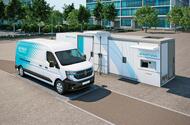The new hydrogen tech delivering 435-mile range vans


Renault’s new Hyvia filling stations are being rolled out across Europe and can be set up in 72 hours
Hydrogen fuel cell projects continue to grow, along with interest in using them to power commercial vehicles and particularly heavy trucks. One such is the new Renault Master H2-Tech Prototype shown at the recent IAA Transportation show in Hanover.
The Master has been developed by the Hyvia joint venture between Renault and US fuel cell specialist Plug. As part of the project, Hyvia has also developed hydrogen fuel cell stations that are being rolled out across Europe.
The significance of the project to car drivers is that commercial hydrogen fuel cell fleets have long been seen as the way to grow a hydrogen refuelling network. Hyvia’s ‘Hywell’ filling stations are clever because they are “containerised and relocatable”, making them relatively easy to set up with a minimum of engineering involved.
One station can supply 100kg of hydrogen a day, which is enough for more than 20 vehicles.
The Master H2-Tech Prototype has a WLTP range of 435 miles and can be refuelled as quickly as a petrol or diesel car. It uses a “dual-power” architecture: a combination of 47kW fuel cell and a 20kWh battery pack.
The fuel cell is a new-generation system based on a Plug fuel cell and is produced at the Hyvia plant at Flins in France.
Fuel cells have an anode and a cathode in the same way as a battery and split hydrogen molecules into protons and electrodes at the anode. The protons travel through an ultra-thin membrane to combine with oxygen from air fed into the fuel cell, and it forms water as a by-product along with heat.
The electrons flow into a circuit to power the electric traction motor, so the combination of fuel cell and small battery replace what would be a large high-voltage battery in a BEV.
The advantage over a BEV is a much longer range and quick refuelling, but the driving experience is the same as that of a BEV. Fuel cells for vehicles are usually combined with batteries to create a reservoir of energy for the transient boost needed for acceleration, while the fuel cell generates a steady flow of power to top up the battery.
The heat generated by Hyvia’s system is used for cabin heating, and the fuel cell uses compressed hydrogen stored in tanks under the floor. There’s a choice of tanks available depending on the range requirement, holding either 7.5kg or 9kg of hydrogen.
Power comes from an AC traction motor and, like a BEV or conventional hybrid, regenerative braking allows energy to be captured when the vehicle slows.
From the end of next year, the Master H2-Tech will be manufactured entirely at the Renault Group plant at Batilly, France, and marketed by Renault.
Source: Autocar RSS Feed
Recent Posts
The EU is betraying its citizens and weakening privacy for political gain
Maybe Apple will never fully walk away from Europe, but the European Commission has just…
Warner Bros.’ Shelved Coyote vs. Acme Feature May Get a Second Chance
A new report says Ketchup Entertainment, which picked up The Day the Earth Blew Up:…
Used Car of the Day: 1968 Ford Mustang
We're staying old school today with this 1968 Ford Mustang. This one has had the…
Trump Threatens to Defund the NYC Subway
Transportation Secretary Sean Duffy is demanding a "safety plan" from the city.
Apple will launch new ‘homeOS’ this year, here’s what’s coming
Apple has a big software year ahead, with major redesigns coming to iOS 19, macOS…
Elon Musk Is Joining Microsoft in $30 Billion Data Center Project
The biggest backer of OpenAI, Microsoft is now building its own AI models and teaming…